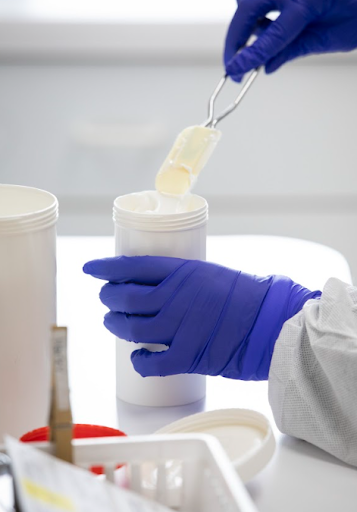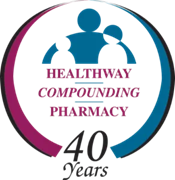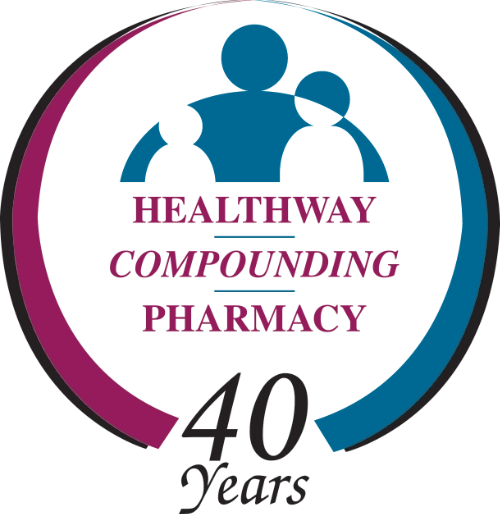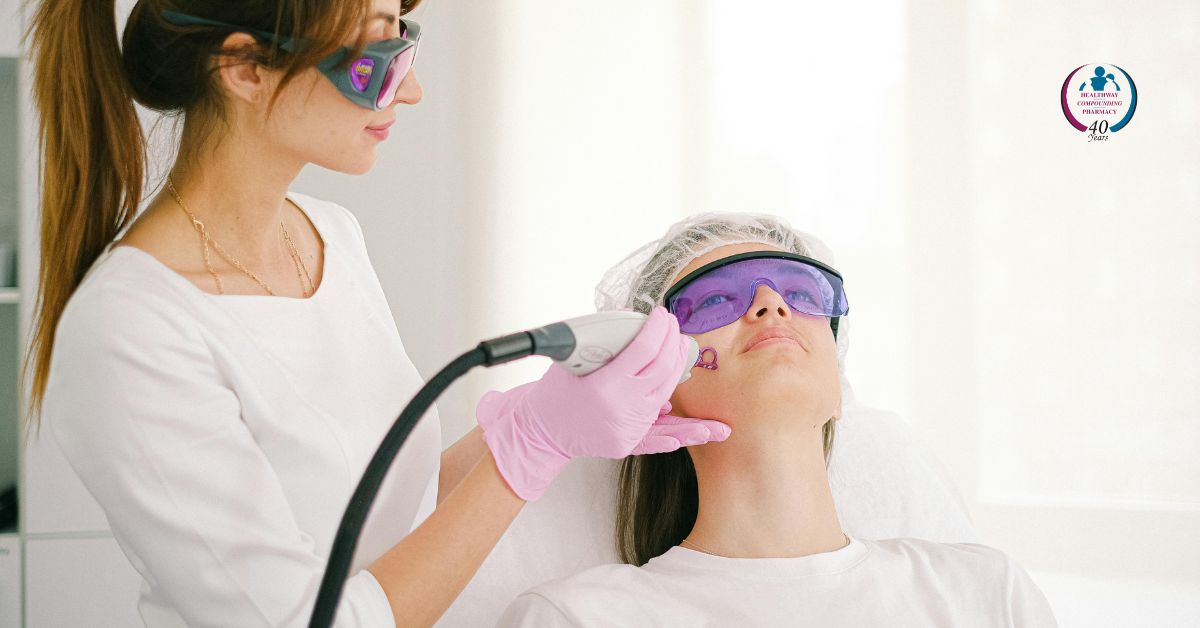Michigan’s Top Compounded Topical Anesthetic: Quadcaine (Bupivacaine/ Lidocaine/Prilocaine/Tetracaine)
Pain is a universal experience, and topical anesthetics are often utilized to manage discomfort in a localized manner. One unique formulation available through compounding pharmacies is Quadcaine, a combination of four local anesthetics: Bupivacaine, Lidocaine, Prilocaine, and Tetracaine.
What is Quadcaine?
Quadcaine is Healthway Compounding Pharmacy’s exclusive, pharmacist-developed topical anesthetic cream that combines bupivacaine, lidocaine, prilocaine, and tetracaine in a carefully balanced formulation.
Designed for patients with pain and medical procedures like laser therapy, microneedling, biopsies, and tattoo sessions, this compounded blend provides a customized approach to localized numbing for patients who need precision and comfort beyond what is commercially available or over the counter.
Understanding Topical Anesthetics
Topical anesthetics function by blocking sodium channels in nerve cells, which inhibits the transmission of pain signals. Quadcaine is typically compounded as a topical dosage form, most commonly in the form of a cream, gel, or solution. It is often prescribed for pain and used in medical, dental, and cosmetic procedures.
These semisolid preparations are intended for external application to the skin or mucous membranes, allowing the active pharmaceutical ingredients (bupivacaine, lidocaine, prilocaine, and tetracaine) to act locally at the site of application. The specific base — cream, gel, or solution — is selected based on the desired absorption rate, patient skin type, and the type of procedure or condition being addressed.
At Healthway Compounding Pharmacy, the formulation can be customized to the prescriber’s specifications to suit individual patient needs.
Components of Quadcaine & Supporting Research
1. Bupivacaine
Mechanism of Action: Bupivacaine is an amide-type local anesthetic that blocks voltage-gated sodium channels, stabilizing the neuronal membrane and preventing the initiation and transmission of nerve impulses.
According to Butterworth et al. (2013), bupivacaine is noted for its longer duration of action, making it useful in procedures requiring extended analgesia.
Related article: Butterworth, J. F., & Strichartz, G. R. (1990). Molecular mechanisms of local anesthesia: A review. Anesthesiology, 72(4), 711–734. Link

2. Lidocaine
Mechanism of Action: Lidocaine, another amide-type anesthetic, has a rapid onset and intermediate duration of action. It works similarly by inhibiting sodium ion channels on the neuronal membrane.
Lidocaine remains the most widely used local anesthetic in the United States due to its favorable pharmacokinetic profile, including a rapid onset and intermediate duration of action, making it suitable for a variety of clinical procedures. Researchers note that “lidocaine continues its prominence as the most widely used local anesthetic in the United States.”
Related article: Becker, D. E., & Reed, K. L. (2012). Local anesthetics: review of pharmacological considerations. Anesthesia progress, 59(2), 90. Link
3. Prilocaine
Mechanism of Action: Prilocaine is closely related to lidocaine but has a slightly lower vasodilatory effect. It also acts by blocking nerve conduction via sodium channel inhibition.
“Prilocaine acts on a sodium channel on the neuronal membrane and minimizes the spread of seizure activity and propagation. The prilocaine exhibits therapeutic action against nerve system.”
Source: Katari, N. K., & Jonnalagadda, S. B. (2022). Prilocaine: Mechanisms and application. Treatments, Mechanisms, and Adverse Reactions of Anesthetics and Analgesics, 151-164. Link
4. Tetracaine
Mechanism of Action: Tetracaine is an ester-type local anesthetic that provides potent sodium channel blockade. It is often reserved for more intense procedural needs.
A study from the Clinical Journal of Pain, supports the use of compounded tetracaine by demonstrating that high-concentration tetracaine effectively reduces pain in patients with trigeminal neuralgia through peripheral nerve block. Their quantitative assessment revealed significant sensory blockade with minimal adverse effects, highlighting its potential as a tailored therapeutic option.
Related article: Radwan, I. A. M., Saito, S., & Goto, F. (2001). High-concentration tetracaine for the management of trigeminal neuralgia: quantitative assessment of sensory function after peripheral nerve block. The Clinical journal of pain, 17(4), 323-326. Link
Why Four Active Pharmaceutical Ingredients (APIs) for Optimal Pain Relief?
The unique combination of four different anesthetic agents in Quadcaine offers a balanced pharmacologic profile that is not commonly found in standard commercial preparations. Each agent contributes a different onset time, potency, and duration of action:
- Lidocaine provides a fast onset for immediate numbing.
- Prilocaine adds a mild profile that complements lidocaine and reduces vasodilation.
- Tetracaine delivers deeper penetration for more involved applications.
- Bupivacaine offers a long-lasting effect, extending the duration of relief.
By layering these distinct pharmacologic properties, the compounded formulation allows prescribers to address varied patient needs more optimally. For example, in procedures such as microneedling, tattooing, or laser therapy, having both rapid onset and sustained anesthetic activity can contribute to a more comfortable experience. This comprehensive approach may be especially beneficial in dermatology, aesthetic medicine, and outpatient procedures where predictable performance across multiple stages of treatment is desired.
Administering Topical Pain Medications
Watch a step-by-step guide on properly using topical pain medications from our expert pharmacist Dr. Edward “Eddie” Wright, PharmD. Questions? Ask a pharmacist >>
Quadcaine Use Cases
1. Dermatologic and Cosmetic Procedures
Quadcaine may be prescribed for use in procedures such as laser therapy, biopsies, and microneedling to support patient comfort.
2. Pain Management Strategies
Providers may recommend topical anesthetics as part of a broader pain management strategy for patients experiencing localized discomfort.
3. Pre-procedural Applications
Some practitioners use compounded anesthetics to prepare areas for injections, tattooing, or other minor procedures.
4. Pediatric and Geriatric Use
Prescribers may choose compounded topical anesthetics for populations with sensitivities or requiring individualized dosing.
Michigan Practitioners Who Prescribe Quadcaine
Various healthcare professionals may prescribe compounded topical anesthetics such as Quadcaine:
- Dermatologists: For skin-related procedures including biopsies and cosmetic therapies.
- Pain Management Specialists: As part of multimodal pain relief strategies.
- Primary Care Physicians: For minor surgical procedures and chronic localized pain.
- Dentists and Oral Surgeons: For mucosal applications prior to injections or procedures.
- Podiatrists: For localized foot pain or minor surgical interventions.
- Plastic and Cosmetic Surgeons: To improve patient comfort during aesthetic procedures.
The Role of Compounding in Quadcaine Preparation
While commercial topical anesthetics typically contain one or two active ingredients, compounding allows pharmacists to combine multiple agents into a single preparation. This customized approach helps ensure that concentrations are aligned with prescriber guidance and patient-specific considerations.
Why Michigan Practitioners Choose Healthway Compounding Pharmacy

Healthcare providers across Michigan, especially in northern communities and the Upper Peninsula, choose Healthway Compounding Pharmacy for several key reasons:
- Vast Experience: With over 40 years in compounding practice, founder Michael E. Collins, R.Ph., F.I.A.C.P., has built a legacy of trust and professionalism in pharmaceutical care.
- PCAB Accreditation: Healthway Compounding Pharmacy in Saginaw, Michigan, has been compounding medications since 1985 and is PCAB-accredited since 2007, ensuring high standards in pharmaceutical quality and patient safety.
- Personalized Service: Healthway’s team works closely with practitioners to develop individualized formulations tailored to specific patient needs.
- Geographic Reach: Based in Saginaw, Healthway serves Michigan statewide, including hard-to-reach parts of Michigan such as the Upper Peninsula, Thumb region, and northern counties.
- Commitment to Quality: Rigorous quality control and adherence to USP <795>, <797>, and <800> standards underscore Healthway’s dedication to patient safety and regulatory compliance.
Practitioners value these attributes when selecting a compounding partner who can provide dependable, personalized, and compliant pharmaceutical solutions. We can ship directly to Michigan patients with valid prescriptions.
Prescribe Optimal Topical Anesthetics for Your Patients
Compounded topical anesthetics like Quadcaine represent an example of personalized medicine in practice. By combining established anesthetic agents with well-understood mechanisms of action, pharmacists and providers can collaborate to meet individualized patient needs within the context of regulated medical care.
For more information on compounded anesthetic formulations and whether they may be appropriate for your clinical practice, contact Healthway Compounding Pharmacy today.
References
Becker, D. E., & Reed, K. L. (2012). Local anesthetics: review of pharmacological considerations. Anesthesia progress, 59(2), 90. Link
Butterworth, J. F., & Strichartz, G. R. (1990). Molecular mechanisms of local anesthesia: A review. Anesthesiology, 72(4), 711–734. Link
Chahar, P., & Cummings, K. C. III. (2012). Liposomal bupivacaine: A review of a new bupivacaine formulation. Journal of Pain Research, 5, 257–264. Link
Gailey, A. D., & Ostrum, R. F. (2023). The use of liposomal bupivacaine in fracture surgery: A review. Journal of Orthopaedic Surgery and Research, 18(1), 267. Link
Katari, N. K., & Jonnalagadda, S. B. (2022). Prilocaine: Mechanisms and application. Treatments, Mechanisms, and Adverse Reactions of Anesthetics and Analgesics, 151-164. Link
Leung, Y. W., & Rawal, B. D. (1977). Mechanism of action of tetracaine hydrochloride against Pseudomonas aeruginosa. The Journal of Infectious Diseases, 136(5), 679–683. Link
Newton, D. J., McLeod, G. A., Khan, F., & Belch, J. J. F. (2003). Mechanisms contributing to the vasoactive effects of prilocaine in human skin. Anaesthesia, 58(1), 6–10. Link
Paganelli, M. A., & Popescu, G. K. (2015). Actions of bupivacaine, a widely used local anesthetic, on NMDA receptor responses. The Journal of Neuroscience, 35(2), 831–842. Link
Van der Wal, S. E. I., Van den Heuvel, S. A. S., Radema, S. A., Van Berkum, B. F. M., Vaneker, M., Steegers, M. A. H., Scheffer, G. J., & Vissers, K. C. P. (2016). The in vitro mechanisms and in vivo efficacy of intravenous lidocaine on the neuroinflammatory response in acute and chronic pain. European Journal of Pain, 20(5), 655–674. Link
Watanabe, T., Hachiya, T., Noguchi, K., Terashima, I., & Uesono, Y. (2014). Tetracaine, a local anesthetic, preferentially induces translational repression of specific mRNAs in yeast. Current Genetics, 60(1), 1–10. Link


